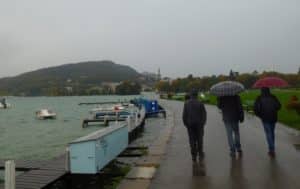Annecy is a mountain town located at an altitude of about 400 metres. It is not governed by the same weather rules as other mountain towns.
A climate tempered by Lake Annecy
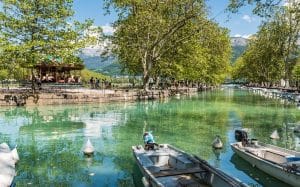
Annecy is located in the heart of the Alps, with the Bornes and Bauges mountains. This makes it a city with a mountain climate.
However, this is tempered by the presence of the lake, which makes it more pleasant.
A mountain microclimate
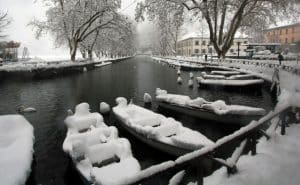
Lake Annecy plays a role in regulating the temperature of the entire Annecy basin. It creates a microclimate where temperatures are cooler in winter and cooler in summer than in other towns in the Alps.
It is rare that the winter is really harsh in Annecy and around the lake. Similarly, summers are rarely scorching and even then, the lake allows you to get over it very quickly and cool off.
Annecy’s weather conditions depend on two factors: the Bauges and Bornes massifs. The temperate climate of the French Alps guarantees temperatures typical of large European lakes, with a marked humidity.
What temperature for Lake Annecy?
The temperature of the lake varies considerably between winter and summer periods. In winter it is between 2° and 8°, while in summer it is between 18° and 26°.
The temperature of the lake is of course dependent on precipitation and outside temperatures. Thus, a summer rarely resembles the previous one. In winter, an average of 25 days of snowfall are recorded each year. This average has decreased in recent years, partly due to global warming. It should also be noted that the lake is now only partially frozen, whereas in the past it was once completely frozen.
The eastern shore of Lake Annecy has the best sunshine
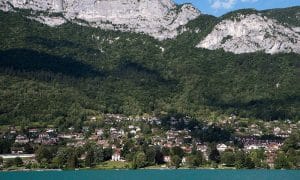
The impact of global warming on Annecy
As can be seen from the diagram drawn up by Météo France, the evolution of average temperatures over 144 years clearly indicates that global warming has accelerated since 1990. The warmest years are 2018, 2019 and 2022. The meteorological evolution is therefore implacable in the Alps and Lake Annecy is no longer sufficient to absorb the rise in temperature. At the same time, rainfall is falling sharply.
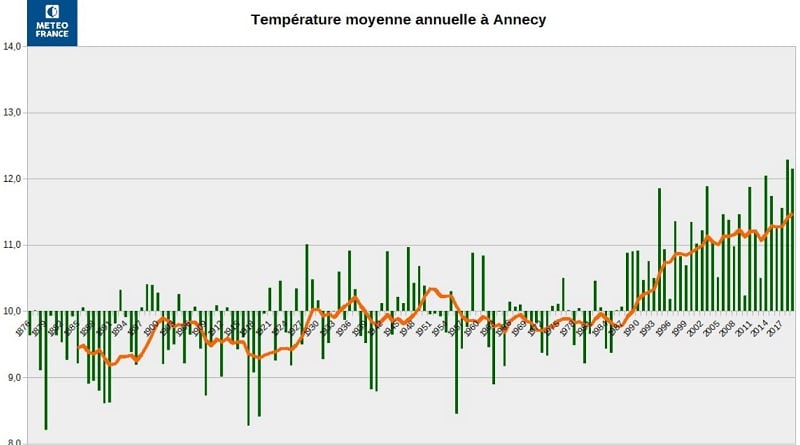
More severe droughts
The warming of temperatures in Annecy is coupled with recurrent droughts. In 2018, the lake reached its lowest level since 1947. In front of the Pâquier, it was possible to walk almost 200 metres without the water level rising above the knees.
That same year, the autumn rains did not come. The lake level did not exceed 16 centimetres compared to an average of 80 centimetres in November. The State services then classified Haute-Savoie as a red alert, the highest level in terms of water deficit. This drought also had an impact on the rivers of Annecy, and fish were no longer able to move. This was particularly the case for lake and river trout.
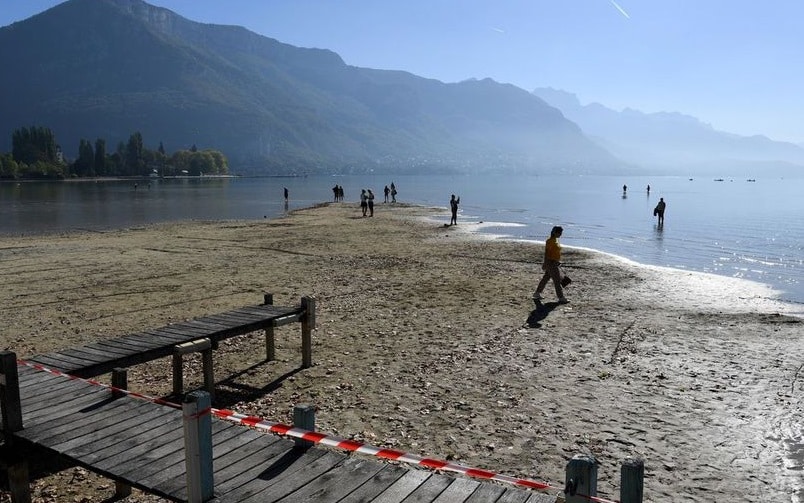
+3.3°C in 2050 in Annecy
Climatologists and meteorologists estimate that temperatures have risen by 2°C over the last twenty years. In 2050, they are expected to have risen by 3.3°C and the average temperature at the lakeside could be 21.8°C during the summer season.
Rainfall patterns have also changed. There is a lot of rain in the winter, while there is almost no rainfall in the summer. This variation in weather is known as the“anticyclonic potato“. It locks in over Europe and pushes back the lows that cannot reach the Haute-Savoie. Weather forecasts for Annecy are therefore easier in summer, as the weather often stays hot and dry for a long time, without precipitation due to the anticyclone. The 15 day weather forecast is also easier. Hour by hour weather forecasts are used by the organisers of the Lake Annecy Festival to know if it is possible to shoot the fireworks.
Ski resorts and climate change
As far as winter sports resorts are concerned, the snowfall deficit is increasing. The resorts are making increasing use of artificial snow. However, this requires large quantities of water, which is drawn from rivers, thus further reducing the water level in the rivers.
The seasons are shifting, as is the case for mountaineering. Landslides are also more numerous, making mountaineering in the high mountains dangerous, as in Chamonix.
When to come to Annecy according to the weather?
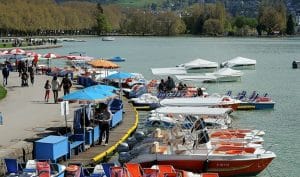
As a result of global warming, heat waves are becoming more frequent and the resulting rainfall can be very heavy. The positive side of this rise in temperature is the increase in the temperature of Lake Annecy, which often exceeds 22°C at the surface in summer.
Visiting Annecy between May and September
The best time to visit Annecy is from mid-May to mid-September, which is the warmest and sunniest time of the year. Sometimes it can be very hot in July and August. However, the nights are usually relatively cool. We therefore recommend that you bring a sweatshirt or jumper and a light jacket for the evening.
Weather forecast for Annecy
Discover now the weather forecast for the coming days in Annecy, as well as for today, in the morning, afternoon, evening or night. For this, we have selected several sites giving the weather.
Why several? Simply so that you can be sure of the weather in the coming days. It is better to have several sources, as the study of atmospheric phenomena such as clouds, precipitation or wind is not an exact science. And for the weekend, don’t forget to check the Sunday weather forecast for Annecy.
7 day weather forecast for Annecy
5 day weather forecast from Météo City
Ta Météo’s 5-day forecast
Many webcams are available to discover the magnificent landscapes of Annecy, its lake and the surrounding mountains. It is also the opportunity to know the weather forecast live to prepare walks and outings in nature. Here are the 14 most beautiful webcams in Annecy.

